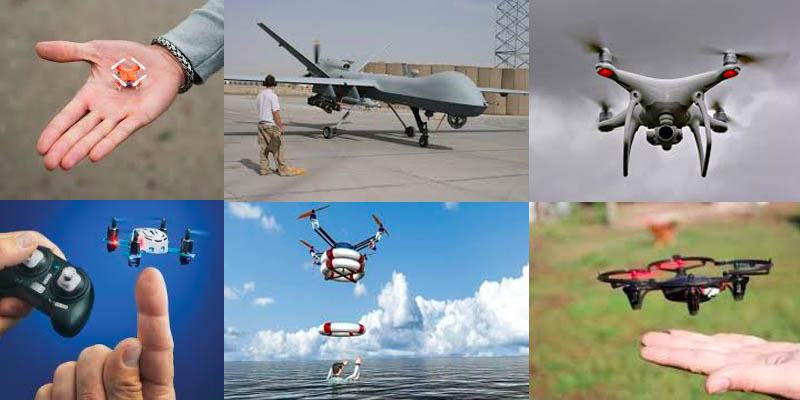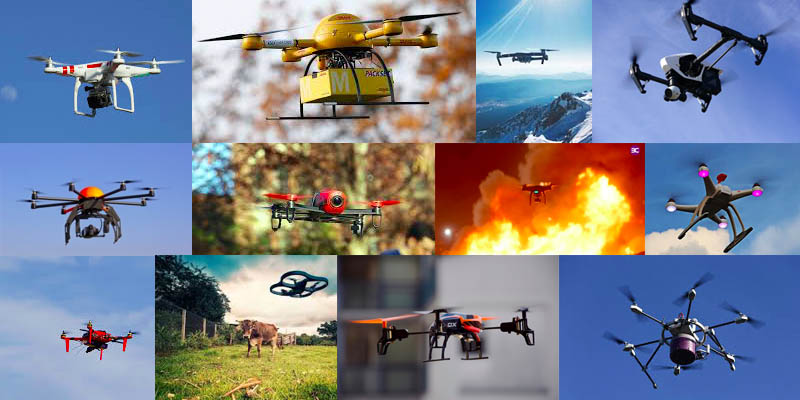21 Types of Drones
Drones are hip. Drones are cool. They’re the must-have toys/machines/robots of the season. You may need them to assist you in your work. You may simply want to play with them. But before buying one, you need to educate yourself on the variety of drones of different shapes and sizes available, so you can choose the one which works best for you. Here are the different types of drones you’ll find on the market:
Depending on Size

The size of a drone can vary greatly, and dictates several factors relating to its performance. Here is the classification of drones according to size:
Don’t Miss: Best Beginner Drones
Very Small Drones
These can be as small as the size of an insect, all the way up to 50cm in length. These are known as nano or micro drones, and are usually used for conducting biological warfare or to spy on people. Their wings or rotors are specially adapted to make them more maneuverable in smaller or enclosed spaces.
Small Drones
These are bigger than the micro drones, but still quite small. They do not exceed 2 meters in length and usually have fixed wings. Small in size and high powered, they can be thrown into the air by hand from where they continue gliding easily in the air.
Medium Drones
These are smaller than light aircrafts, but still quite large. They usually need to be carried by two people, and can weigh up to 200kgs.
Large Drones
These types of drones are as large as a small aircraft. The military frequently makes use of these drones and sends them to areas of high risk in place of fighter jets containing officers. Surveillance duties can also be carried out by these drones thanks to extremely powerful cameras attached to their bodies which can study an area from several hundred feet up in the air.
Depending on Range
Range refers to how away from the user a drone is capable of flying. You can choose from among several options for the amount of range you wish your drone to have, including:
Very Close Range
Toy drones usually come under this category. These drones have a range of around 5km. They can stay in the air for 20 minutes or longer, up to an hour.
Close Range
These can be controlled from up to 50km away from the user. A powerful battery allows them to stay in the air for up to 6 hours. The military uses these drones often.
Short Range
The drones which can be controlled from 150km away are known as short range drones. They can stay airborne for up to 12 hours, and are another breed of drones that are popular for the purpose of spying and surveillance.
Mid-Range
You can control these drones from as far away as 650km! While surveillance is a natural use for these drones, they are also a popular choice for collection of scientific data relating to the weather, and geology of a particular region.
Depending on the Type of Aerial Platform

Drones do not follow a set method of flying. Let’s take a look at the classification of drones based on how they manage to stay up in the air:
Multi Rotor
These drones carry several motors on their bodies. They can stay in a stable position in one spot in the air for a long time, so they are a popular choice for aerial photography and surveillance.
Fixed Wing
The other major drone design consists of the fixed wing model, where the drone mimics the construction style of aeroplanes. These drones cannot stay in one place, but instead glide on their set path for as long as their energy source permits.
Single Rotor
A single rotor is used to fly the drone, while another, smaller rotor near the tail controls the direction. Also known as RC helicopters, these drones are more efficient than multi-rotor drones. They can fly higher, stay in one position without spinning, and often use gas to power their bodies instead of electricity.
Depending on Abilities

A drone is so much more than a simple flying machine. It can perform a variety of tasks, which is why different drones have been set apart from each other based on their ability to perform a particular job, such as:
Quadcopters
The most popular model on the market, the quadcopter uses 4 rotors positioned at the ends of a square on the drone body. This design is used to create toy drones as well as bigger, worker drones.
GPS Drones
These drones are linked to satellites via GPS. The drones makes use of the satellite to decide the direction of their flight, and return to the owner after running out of battery.
RTF Drones
Ready-to-fly drones are quick and easy to use. Simply buy the drone, take it out of the box fully assembled, and charge it up. A great point of introduction to the world of drone flying!
Trick Drones
Small, fast and maneuverable, trick drones are usually used as toys, and can perform barrel rolls, flips and other flashy and entertaining moves in the air. They do not usually come with extra accessories that might weight them down.
Helicopter Drones
This model uses a single rotor to stay up in the air. It resembles a remote-control helicopter that can stay in the air for a long time.
Delivery Drones
These are fast becoming a popular choice with companies that need to move inventory. Delivery drones have an anchor or basket attached to their body where the package can be affixed and transported by the drone. While today’s drones are limited in terms of the size of the package that they can carry, researchers are working round the clock to create bigger and better delivery drones for transporting larger goods.
Photography Drones
These drones have a camera/video camera attached to their body. These accessories can take HD quality snaps and videos of the world from the drone’s perspective, and are specially built to withstand the damage done by harsh weather to the cameras.
Racing Drones
Fast and agile, these drones are shorn of any unnecessary additions to keep their shapes streamlined and free of excess weight. Racing drones can reach speeds of up to 60 miles per hour and are used in competition and championships by drone enthusiasts.
Alternative-powered Drones
Not all drones are powered by electricity. A class of drones exist which run on gas power, while nitro-fuel powered drones have also been developed, usually for racing purposes.
Endurance Drones
The best drones for flying far and long. Endurance drones can stay in the air for three consecutive days, and can reach mid-boggling heights of 30,000ft above sea level.


hi I think drones are so cool
and I didn’t know there was different types of drones in the world.
from kokum
Yeah so cool, didn’t each and every different types has it’s good points
y won’t u know…. SMH
A quad-copter is a multi-rotor drone not a single rotor drone. You might want to fix that.
Thanks for pointing that out!
Nice!!
Great for beginners.
I’m new to this kind of passion and I’ve learn some basics because of your site.
Thanks a lot for the information.
joseph pls i want to learn more from u pls
Hi . I need the details of rotors used for different types of drones based on application